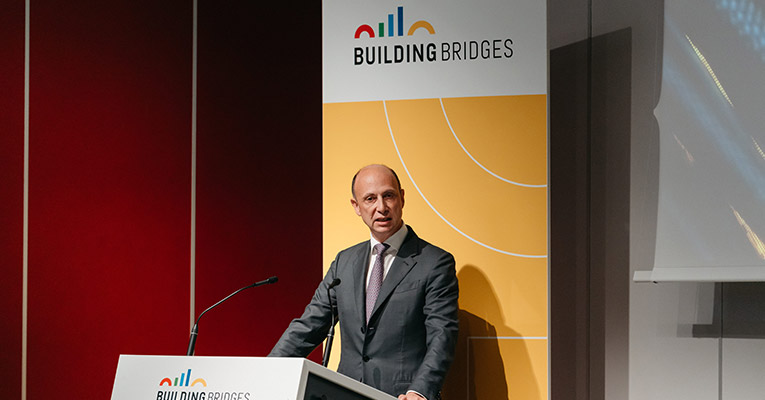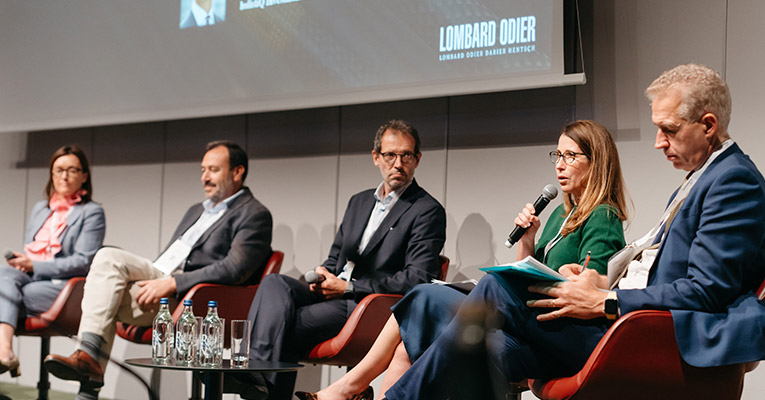corporate
Building Bridges 2023: an EUR 2 trillion opportunity as the economy goes electric

“The scale of the electrification transformation is huge. By 2030, we’ll have invested more than USD 24 trillion of capex. By 2050, 70% of the economy will be electrified [up from 20% today]. This is disrupting supply chains, shifting profit pools and giving rise to innovative new business models. Investors have a key role to play in accelerating the transition, and in the promising investment opportunities it is unlocking.”
That was the message from Jean-Pascal Porcherot, Managing Partner at Lombard Odier, as he introduced a debate entitled, “Electrification: the Greatest Opportunity in Capitalism’s History?” at Building Bridges 2023 in Geneva. The panel, which brought together a broad spectrum of leading voices from across the energy industry, formed a key part of the conference’s “Action Days”, a chance to advance global sustainable finance and forge new collaborations between finance, industry, NGOs and policymakers.

Read also: Towards an electric future: investors at the heart of a new industrial revolution
A huge transformation
Michael Urban, Lombard Odier’s Chief Sustainability Strategist, explained that policy is a key driver of the electrification transformation. “Policy action is at an all-time high. Support is unprecedented,” he said. Highlighting commitments including China’s emissions trading scheme (the world’s largest carbon market) and the Chinese Communist Party’s promotion of wind, solar and hydroelectricity production in their current Five-Year-Plan on Renewable Energy Development, he said, “When we look at the European Green Deal, the Inflation Reduction Act in the US, and policy in China, we forecast hundreds of billions of dollars being deployed every year by governments to support the transition.”
However, while policy is important, he explained that economics has now taken control. As new technologies (on both the electricity production side – such as solar and wind, and the consumption side – such as heat pumps) begin to beat incumbent technologies on price and performance, “capital deployment expands, production capacity increases and that unlocks economies of scale. All of a sudden it’s a very compelling economic basis for consumers and businesses. That is ultimately what is unlocking this green growth story.”
Surprisingly, Michael Urban said, even as demand for electricity increases rapidly, overall final energy consumption is projected to fall. Such is the efficiency increase in electric demand-side technologies – with heat pumps three times as efficient as gas boilers and electric motors three times as efficient as internal combustion engines – that the energy system of the future will be required to produce and transport less energy than it does today. This remains true, he said, despite projections that the global economy could more than double in size by 2050.
The industrial transition
Kingsmill Bond, Senior Principal in the Strategy Team at RMI (formerly Rocky Mountain Institute), a non-profit working to accelerate the clean energy transition, picked up on the theme of energy efficiency. “[Electrification] is three times more efficient, at least, than anything the fossil system can do. It has many spectacular advantages,” he said. “Electricity is now the largest source of useful energy. Furthermore it’s the only piece of the energy system that’s growing. Everything else has peaked.”
This peak, he explained, has been driven by rapid industrial transition to electricity in China. Highlighting the difference between heavy industries and less energy- and resource-intensive light industries, which typically produce smaller consumer items such as toys and home textiles, he said: “Everyone talks about how hard it is to decarbonise heavy industry. But it’s relatively easy to decarbonise light industry. Chinese light industry is electrifying so quickly that global fossil fuel demand within industry peaked in 2014. All of the growth since 2014 in the industrial sector has come from electricity, specifically driven by the electrification of the Chinese light industry.”
Camilla Nilsson, Chief Executive Officer at Kyoto Group, which is now commercialising its innovative salt-based battery that converts renewable electricity into heat for industrial plants and district heating systems, noted that the electrification transition can now extend into heavier industries, too. “Two thirds of the energy demand of an industrial plant is heat,” she said. “Today, almost all of that is produced by fossil fuels. But there is technology to replace that gas boiler and it’s proven and scalable. We can do it today.”
The grid of the future
Debate moderator Mattia Romani, Chief Policy Officer at holistiQ Investment Partners, asked the panel to consider what the power grid of the future would look like as demand for electricity rises, and whether we have sufficient materials to build the infrastructure needed.
Agustín Delgado Martín, Chief Innovation and Sustainability Officer at Spanish renewable energy firm Iberdrola, explained how Spain has achieved a dramatic shift to renewable electricity by decentralising the grid. “Before, we had 30 locations that generated power. Now we have 300, because renewable sources are, by their nature, distributed geographically. The new system that we’re building is totally decentralised. In 2005, we believed that only 20% of a system could be renewable, and no more than that. Now, in Spain, we have days and even weeks of up to 80% renewable energy.”
When it comes to materials, Kingsmill Bond said, “the impact of a renewable system on nature is dramatically lower than the impact of a fossil fuel system.” We burn 15 billion tonnes of fossil fuels a year, he explained, but need just 35 million tonnes of critical minerals.
Turning specifically to whether we have sufficient rare earth materials – such as the lithium and cobalt needed to make batteries – he said, “As with anything, when you move from small amounts to exponential growth, which is what we have now, you’re going to have teething problems. There are going to be times when demand is higher than supply. But the answer isn’t to say, ‘we can’t do it.’ The answer is to figure out solutions.”
“Those solutions include, for example, a massive increase in circularity. They include recycling and efficiency with our use of resources, such as getting cobalt out of used batteries. If we don’t do those things then we will struggle. But if we do all those things right then we have plenty of minerals.” According to the International Energy Agency, he reassured delegates, there are sufficient resources available.
The panel heard that the electrification revolution will need 2 million kilometres of new grid infrastructure to be built every year – enough to wrap around the circumference of the earth fifty times. For Agustín Delgado Martín, this massive infrastructure build presents an opportunity for investors. “You need to invest in grids heavily. Because of the long duration of these assets, which are meant to last for 50 or 60 years, the impact on the customer is just 1.5 to 2 euros per megawatt hour (MWh). The investments needed are very high, but the impact on bills is going to be very low. There is no technical problem, there is no investment problem, there is no resource problem and there is no problem for the customer. So the grid system is not a problem for the energy transition.”

An EUR 2 trillion opportunity
According to Michael Urban, the “flip-side” of this rapid electrification scale-up is a decline in fossil fuel energy. “We’re talking about a fundamental rethink of the energy system. Already, back in 2022, we’ve seen clean technology capex investment – at about USD 1 trillion – outpacing capex going into the maintenance of oil and gas infrastructure – at around USD 800 million. Corporates are seeing future sources of green revenues and profits, and they want to chase that through upfront investment.”
Kingsmill Bond agreed, explaining that the renewable electricity industry is targeting what he called the “giant rents” of the fossil fuel system.” “It costs Saudi Arabia USD 10 to get oil out of the ground, and they sell it for USD 100,” he said. “That’s USD 90 rent. Add it all up and it’s EUR 2000 billion a year. That’s the opportunity for electrification.”
Despite the enormous opportunity, and the efficiency and cost advantages of electrification, Mattia Romani noted that electrification stocks have underperformed on listed markets in recent months. “Why is the stock market not there yet?” he asked.
For Agustín Delgado Martín the problem is only short-term. “For the energy transition you need a lot of capex. When you have high interest rates then money sometimes flows not for these high capex investments, but to the bonds. But this doesn’t mean we are slowing the level of investment.”
Kingsmill Bond agreed, noting that any disruption to capex flows would only be short-term. “I don’t think we should worry that that’s disrupting the story. There’s a lot of capital coming into this space chasing returns. You will have some amazing winners, on digitisation, or green enhancing technologies, or cable technologies.”
A no-brainer
“The other side of the equation is that the fossil fuel system is incredibly vulnerable,” Kingsmill Bond continued. “They are facing peaking demand already, and then a plateau until the middle of this decade, and then permanent catastrophic decline. So I think one of the things that investors now need to do, rather than worrying about their renewable investments, is worry a lot more about their fossil fuel investments, because that’s where the real risk now lies.”
For Michael Urban, this move away from fossil fuels “is unlocking massive revenue pool shifts.” “Investors,” he said, “have a key role to play in accelerating the transition, and in the investment opportunities it is unlocking.”
The fact that stock markets are failing to attribute true value to electrification stocks, he explained, “is why we think this is so attractive. When we look at how the market is valuing electrification-related companies they’re more or less on a par with the broader equity market. Yet when we look at them in terms of their capital efficiency, so return on equity, it’s significantly higher, and also offers up to twice the growth. The same valuation for up to twice the growth – that should be a no-brainer to most equity investors.”
Important information
This document is issued by Bank Lombard Odier & Co Ltd or an entity of the Group (hereinafter “Lombard Odier”). It is not intended for distribution, publication, or use in any jurisdiction where such distribution, publication, or use would be unlawful, nor is it aimed at any person or entity to whom it would be unlawful to address such a document. This document was not prepared by the Financial Research Department of Lombard Odier.
Read more.






share.